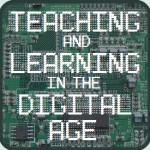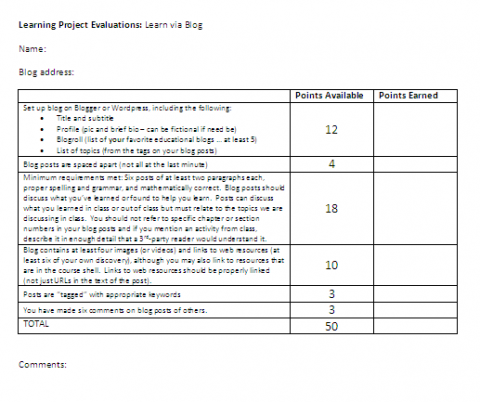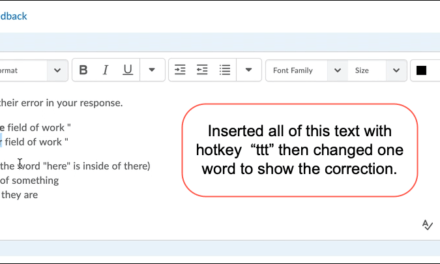 Last semester I began using learning blogs as one of the assignments for Math for Elementary Teachers. It was the first time I have ever used blogs as a graded student learning assessment, and I didn’t really know what to expect out of the students. Would they all have created blogs before? [no] Would they understand intuitively how to make hyperlinks, load in images, and embed videos? [no, no, and no] Would they write naturally in a conversational tone (in the style of most blogs)? [yes] Would they make their blog posts two or three times a week (as directed) or would they cram them all in during the last couple days? [some of both]
Last semester I began using learning blogs as one of the assignments for Math for Elementary Teachers. It was the first time I have ever used blogs as a graded student learning assessment, and I didn’t really know what to expect out of the students. Would they all have created blogs before? [no] Would they understand intuitively how to make hyperlinks, load in images, and embed videos? [no, no, and no] Would they write naturally in a conversational tone (in the style of most blogs)? [yes] Would they make their blog posts two or three times a week (as directed) or would they cram them all in during the last couple days? [some of both]
Overall, I was thrilled with the results. The students reflected on their learning, both in class and out of class. They found and shared games, videos, articles, and vocabulary sites that they found on the web. Some of them acted as a class reporter, summarizing what was covered in class each day (with their own personalities coming through). Before you read the rest of this post, you might want to browse a few of their blogs to get an idea of the variety or writing and styles.
So let’s just say that this first time using blogs was a learning experience for both my students and for me. I drafted a rubric for grading the blogs, and stuck to it all semester. However, I realized that both the clarity of the assignment and the specificity of the rubric needed to be improved for “Round Two” (starting next week).
During the last round of blog grading, I revised my old rubric to try and tighten up the quality of the results. Here are the specifics of the assignment now.
Set up a blog using Blogger or WordPress. You should make at least six blog posts of at least two paragraphs each, using appropriate spelling and grammar. The mathematics in your posts should be correct. Blog posts should focus on what you have learned, what you’ve struggled with, or what you’ve found to help you learn. Posts can discuss learning in class or out of class, but must relate to the current topics we are covering in the unit. You should not refer to specific chapter or section numbers in your blog posts, and if you mention an activity from class, please use enough detail that a 3rd party reader would understand it. Here are some specific details:
- Blog posts should be spaced apart (not all at the last minute).
- Your blog should include an appropriate title (not just Maria’s Blog)
- Your blog should include a profile (picture and brief bio). This can be fictional if need be.
- Your blog should contain a “blogroll” with five of your favorite educational blogs.
- Your blog should contain a list of tagged topics or categories.
- Your blog should contain four images (or embedded videos) and should contain at least six links to web resources that you’ve found yourself.
- Links to web resources should be properly “clickable” within the text of the post (not just a pasted URL).
- Each post should be tagged with appropriate keywords.
- You should make at least six comments on the blog posts of other students.
I think that the nature of the blog (what to write about) needs to stay as open as possible, but the fine detail of the assignments is difficult to assess if the quality of blogs varies wildly. If you choose to try an assignment like this, I highly recommend a table-style rubric (like the one below) to keep track of where you are assigning points.
 I also found it helpful to use a screen-capture program (I used Jing and SnagIt) to make grading comments about specific blog posts (because, of course, you should not comment those in on a public blog site).
I also found it helpful to use a screen-capture program (I used Jing and SnagIt) to make grading comments about specific blog posts (because, of course, you should not comment those in on a public blog site).
One last tip: About halfway to the deadline, I give every student feedback on how they are doing so far. I gently remind them about details that they might have forgotten so that they have time to correct or regroup. I’ve found this results in immediate improvement in the blogs and is well worth the effort. I use quick 1-3 minute Jing videos to give the feedback most of the time.
Note: You can see the rest of the learning projects and a “big picture” idea of how I fit all this in (timewise) by reading Transforming Math for Elementary Ed.




